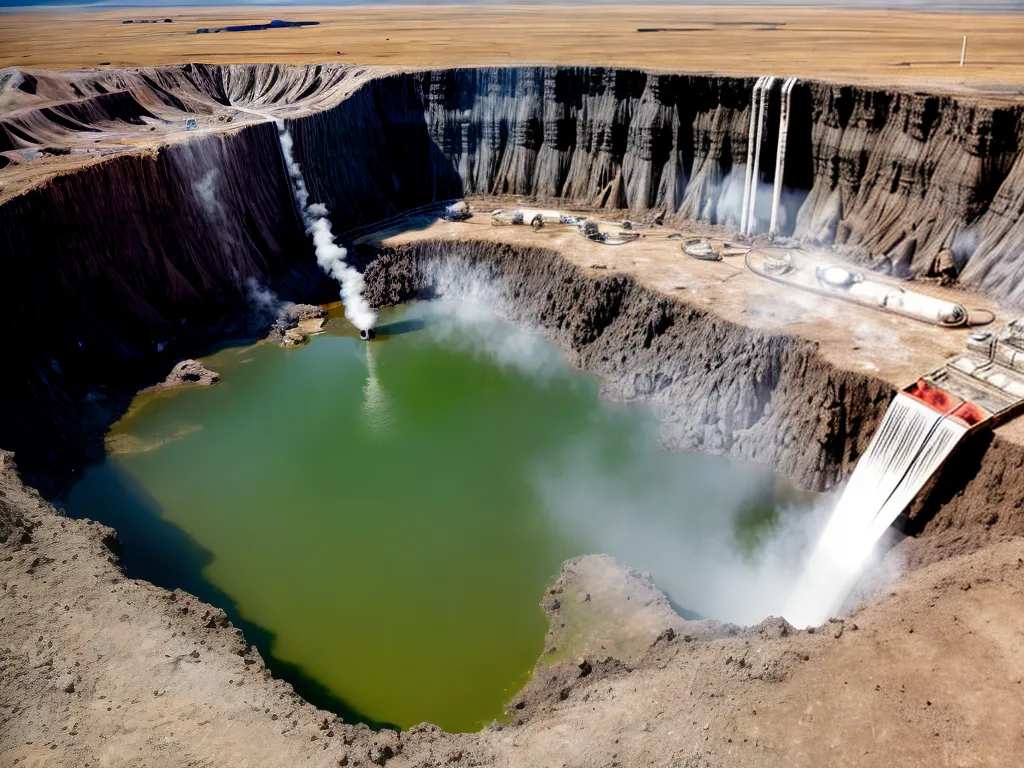
Geothermal energy, which utilizes the Earth's natural heat for electricity production and heating/cooling purposes, is often touted as a clean, renewable energy source. However, like any technology, it comes with some hidden dangers that the general public may not be aware of. As a concerned citizen, I believe it's important to understand the potential downsides of geothermal energy.
1. Water Pollution
Geothermal plants require large amounts of water to transport heat from underground reservoirs. The water is cycled back into the ground but can pick up harmful minerals like arsenic, mercury, and boron during the process. If not properly treated, this can pollute lakes, rivers, and aquifers. A study by the California Energy Commission found that geothermal plants were contaminating groundwater supplies with toxic metals at levels exceeding federal drinking water standards.
To prevent water pollution, geothermal plants must use water treatment systems and zero-liquid discharge technology. This increases costs and energy usage. There is also a risk of spills and leaks. Overall, geothermal energy has a higher water usage footprint per kWh compared to some other renewable sources.
2. Sustainable Water Usage
In addition to possible contamination, geothermal plants consume significant volumes of water for drilling and power generation. This can strain supplies, especially in arid regions. The large geothermal industry in California has faced scrutiny for overusing water resources already depleted by drought and climate change.
Sustainable water use is a major challenge for geothermal energy. Plants must tap into plentiful aquifers and use advanced recycling/reinjection techniques. Even then, depleted reservoirs may require resting periods to recharge. Water usage limits could constrain future geothermal development in water-scarce areas.
3. Land Subsidence
Excessive water pumping from geothermal reservoirs can cause the land above them to sink or subside over time. This occurs when fluid volumes are not replaced at the same rate as extraction. Subsidence has been measured at over 1 foot per year near some geothermal fields in Nevada.
Land subsidence damages infrastructure like roads, pipelines, and buildings. It can also permanently reduce underground water storage capacity. Subsidence is difficult to predict and control. Careful reservoir monitoring and management practices are needed to prevent this geological hazard.
4. Induced Seismicity
The high pressure water injection used in geothermal energy production can induce small to moderate earthquakes, also known as induced seismicity. A 2006 Basel project in Switzerland was shut down after causing several 3+ magnitude quakes that damaged many buildings in the city.
While most induced seismic events are too small to be felt at the surface, larger tremors near urban areas can put public safety at risk. Swiss insurer Swiss Re found that geothermal projects in Europe and Australia had accident rates over 10 times higher than conventional power plants. Proper site selection, injection controls, and seismic monitoring are critical to minimize seismic hazards.
5. Noise Pollution
Geothermal power plants generate noise pollution from heavy equipment like drill rigs and pumps. During the construction phase, continuous loud noise can emanate from the site, severely impacting nearby residents and wildlife.
Some geothermal plants also produce noise during operation, unlike wind and solar installations. Residents have filed noise complaints against operating geothermal plants in Australia, New Zealand, and Hawaii. Noise can harm human health, disrupt wildlife, and reduce property values. Strict noise limits must be imposed and monitored.
6. Surface Instability
The drilling and pumping activities required for geothermal energy can destabilize the ground surface. This causes increased risks of ground settlement, soil liquefaction, slope failure, and surface fissures.
In Pohang, South Korea, a geothermal power plant triggered a 5.4 magnitude earthquake in 2017 that injured 135 people and damaged 57,000 buildings, mostly due to surface instability problems. These geohazards pose a threat to those living and working near geothermal sites. Careful geological and seismic analysis is needed during siting and construction.
7. Hydrogen Sulfide Gas Emissions
Geothermal reservoirs often contain hydrogen sulfide (H2S), a toxic gas that can be released into the air during drilling and energy extraction. At high enough concentrations, this rotten egg-smelling gas is lethal. Lower levels can still cause health issues like asthma, nausea, and headaches while also contributing to air pollution.
In 2017, elevated H2S emissions from a plant in Rotorua, New Zealand led to almost 5,000 odor complaints from residents. Facilities must closely monitor and control venting. Nearby populations may need to be supplied with gas masks as a safety precaution. Gas treatment systems can help clean emissions but add to costs.
In summary, geothermal energy has several hidden dangers surrounding water usage, ground instability, noise, and emissions. With careful siting and management, these risks can be minimized but not fully eliminated. Geothermal technology continues to improve, but it may not be appropriate in all locations. Citizens should consider both the pros and cons when evaluating geothermal projects in their local communities. What are your thoughts on the hidden dangers of geothermal energy? Let me know in the comments below!